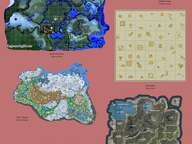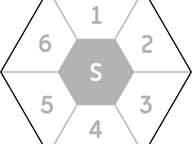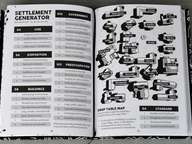Central to a hexcrawl is the exploration. So far however, there wasn't much exploration. The map was predetermined and apart from random encounters there's not much surprise. A standard 6 mile hex is huge though. It has an area of about 25 square miles (or 65 km2). It is unlikely that there's nothing. Something that characters can discover.
The Alexandrian and I seem to agree:
[...] every hex is keyed [...]
There shouldn't be any hex that hasn't at least one feature. One thing that can be discovered. I applied this principle before in my adventure. Other hexcrawls did the same. You can fit the entirety of Skyrim into a single 6-mile hex.
There are different approaches how you can handle the inside of a hex and thus the placement of these features. Some prefer having a subhexcrawl in each hex. A different scale of hexes if you will. Were the "world" hex would have been 6 or 8 miles, the individual subhexes would be something like one or half a mile wide.
The other approach is more abstract. Features just "live" inside a hex. Since our hexes are already quite fluent in their size (as they are measured in time instead of distinct distances), this approach works far better. And it removes the need on drawing another hexmap.
Landmark, Hidden, Secret
Each Hex is divided into 6 sectors like this.
Features are then placed into these sectors. The amount of features is determined randomly (1d6).
One nice thing about these sectors is, that it also solves the problem on where you end up once you enter a hex from another hex.
Image you enter the hex from the north (i.e. walking south - going down). You would walk from sector 4 of the old hex to sector 1 of the new one. Moving from one sector to another one in the same hex is only possible if you move counter- or clockwise. So you can move from sector 1 to sector 2 or 6. But to get to sector 3 you have to go via sector 2.
Every feature is either a Landmark, Hidden or Secret.
Landmark
Landmarks are things that are very obvious to the characters. Things that are maybe even known by the local villagers. Examples include wizard towers, old ruins, etc.
Upon entering a new hex, you roll for a feature and this would be the landmark of this hex. As every hex has at least one feature (no way to roll a 0 on a d6), it will guarantee that we always have a landmark.
This is automatic. There's no "perception" roll needed. The landmark is there. Visible.
Hidden
The next step up are hidden features. Some resource needs to be paid to get this information. Most often this is time. It becomes obvious once you invest the resource, but until then it is hidden.
Examples could be a cave entrance, hidden behind some bushes. Or the cave could be visible, and you have to invest some time to find a path to that cave. There's maybe a treehouse on one of the trees in a forest.
Importantly though, it is guaranteed that you find something. There's still no roll involved (apart from generating the feature of course). Once you invest resources, you get it. All the remaining features that are present in the hex are hidden. So there are between zero and five hidden features per hex.
Secret
Like hidden features, you have to invest resources to find them. However in contrast, you might fail. A roll is needed. They can only be discovered if you have some other information about them. A clue on what you are even searching for. You need to know about its (possible) existence.
You could think about them like "quest locations". Villagers might tell you, that there's a Wolf's Den in the nearby forests. They don't know where exactly so you have to check every forest hex for it. But there's no guarantee that you find it (it might not even exist, the villagers might have lied to you or just don't know it better).
Astute readers might have gleaned, that secret features are not part of a sector of the hex. They are somewhat detached from them. So even if you discovered all features of a hex, there's always space for a secret feature later on. But there can be at most one secret feature per hex.
Rolling for Features
But what are these features exactly? How do we generate them? Features are created as they are needed - in contrast to the hexmap itself, which we created upfront. Features are procedurally generated.
A great resource is Filling in the Blanks from Todd Leback. There are a vast variety of different features. From the standard caves and dungeons, to terrain anomalies, simple dwellings and more. Unfortunately the presentation needs getting used to. Some information is also put into text and is sometimes hard to parse.
Another great set of resources are Worlds Without Number (free edition) and Wilderness Hexplore (Revised). There are probably a plethora of other resources as well.
The thing is - It is a bit of a trap. It is in fact the trap I fell into in the first attempt. Too many options and book you need to carry around with you. I'm slowly working on a set of tables that fit on what I want. And I suggest you do the same. Spend some time into picking what you want from different resources and compile them into a single resource.
Courtesy of The Black Hack
For example I'm quite fond of bundled random tables, where you roll one set of polyhedral dice and then get all the needed information from that. This makes feature generation really quick.
Everybody has their own preferences and this will make the hexcrawl unique to you.
Procedures
Once you interact within the hex, the timeframe shifts. Were before, everything was measured in days, we now handle everything within hours. It is here "watches" return. However we will use a different twist to it.
The day is divided into 4 watches. However they will not be equally sized. Three watches indicate the day part. Morning, Midday and Afternoon. They are roughly 4 hours each. So in total 12 hours. The day starts at 08:00 (8am) and thus lasts until 20:00 (or 8pm).
The night is covered with a single watch that is 12 hours long.
During each of these watches you can take one action and thus adds a die into the Tension Pool.
- Track - Following something or someone from established spoors and signs. We know that they are either in this hex or moved somewhere else. But we know our target. Normally used to track animals or persons. Does not uncover features.
- Search - We don't know if something is in a particular hex or where in the hex, but we know of it's general existence. We try to answer the question: Is X here? This is to find Secret Features.
- Explore - When searching without a goal. It answers the question: What is here? The result is random (it could even be a boat). This is to find Hidden Features.
- Hunt / Forage - Gathering resources such as food and water.
Normally you won't be doing anything during the night, because that watch is used to cook, eat, sleep and keeping watch. So that's why it is compressed into one single activity (instead of playing out 3 individual watches - were mostly nothing is happening). But you could do any of the above actions in the night as well. But then it would be reckless - with all it's consequences. You still can only do one action though (as it being dark, the action is quite a bit harder and takes more time as it would in broad daylight - since you have to carry around some light source for example). But sometimes it might be necessary.
4 watches per day also means that after 3 days you should have 2 rolls of the tension pool (if nothing else is happening). This is I think an acceptable number. It also means, that the watch were you roll the pool is also always different. So at one point you might have an encounter in the night. This removes the need to check if the encounter happens at night, as it automatically progresses through the watches.
You can also vary the amount of daytime actions depending on the season. So summer you get an additional action, whereas in winter nightfall comes quicker.
Foraging and Hunting
A very simple procedure for foraging goes as follows: Roll a d6 and add modifiers. Positive modifiers are bountiful terrain (such as plains and forests, or coasts), special abilities of characters (such as rangers). Negative modifiers might be barren terrain. For every point equal and above 4 you gain a fresh ration. So a roll of 5 gives 2 fresh rations.
Fresh rations however can spoil within a day, if not eaten, and need to cooked to be preserved (almost) indefinitely. You can spend some time in the night (or any other watch) to cook. For every fresh ration you want to cook, roll a d6. On a 3 or higher, the fresh ration becomes a normal ration. Cooks (or similar skills) add 1 to the roll. Everything below is burnt and can't be eaten anymore.
Traveling in subhexes
We now have two different time scales. Traveling between hexes is measured in days and moving within the hex is hours (and somewhat abstract hours at that). What if we want to explore a bit in a hex and then move to another?
Travelling from one hex to another always takes a day (1 hex = 1 day). So no matter what time of day you depart from one hex, you will arrive at the next hex at the same time the next day.
So let's say you start on day 1 at hex 1 at 08:00. You go to another hex. So it is now day 2 at 08:00. You start exploring that hex a bit, let's say you explore two sectors. Then it is now 16:00. You start moving to the next hex. You will arrive there on day 3 at 16:00. In between you can't take any other action, other than traveling to the hex.
Summary
This concludes my lengthy foray into solo hexcrawling. There has been a lot of information. Some of it I already tweaked in some places and changed over the course of these articles. The rough mechanics stand however.
Of course most of it hinges on random tables and as I mentioned, these take the longest time to get right (or at least into an usable state). This is the crux of solo gaming. The more random tables you have the better. But ideally they are all in the same place. Which currently they are not (along with all the other information). I'm working on that.
I feel, hexcrawling is one of these things that is very personal to every GM (or even player). Especially when it comes to stocking hexes, travelling and encounters. There are so many debates on what is right and what not. In the end it is all preferences. Which is the core of RPG's anyway.
Procedures
This is a very short summary of the procedures presented in all three articles.
Preparation (Create a new Province):
- Roll 2d12+6 and mark border around that number of hexes
- Determine biome
- A common, uncommon and two rare terrain
- Roll for each hex to determine terrain
- For every hex roll 1d12, on a 12 add a settlement at that hex
- Place roads between settlements as you see fit
- Place at least one road that enters and exits the province
- Place rivers as you see fit
- Determine one major faction of the province
- (optional) Determine encounter table for province
- Name the province
The Tension Pool is now in play
Traveling (Hex-to-Hex):
- At the beginning of the day, roll for weather
- Move to new hex
- if this is a new hex, roll 1d6 to determine amount of Features
- Roll to determine Landmark Feature of this hex
- Rest and eat a ration
Exploring (Subhex):
- The day is separated into four fragments
- 3 daytime actions, 1 night action
- Possible Actions
- Explore
- Search
- Hunt/Forage
- Track
- Actions during the night, are reckless
Further Reading: How do you handle the "Inside" of a Hex?, Echanted Nimbus #1, Sienas 6 mile hex, Filling in Blanks


